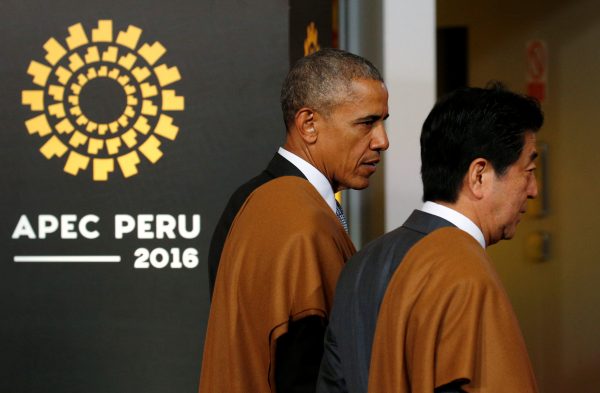The 2016 ELM in Peru will generate some entertainment. President Obama will be interrogated about the likely impact of his successor and will try to provide reassurance without commitment. The result of the election is clear, even if extraordinary. There was never any chance of a repeat of then US president Bill Clinton’s ‘Triple Whammy’ — the Uruguay Round, North America Free Trade Agreement and inauguration of the APEC ELM — but few considered the likelihood of a complete reversal.
The immediate question is where US policy is likely to engage, considering there is widespread scepticism of the value of economic integration. Will US policy endorse and promote that scepticism? Will ‘American Jobs First’ be the new form of ‘America First’? Such questions will not be answered in Lima.
The nearest the official agenda will come to such questions is discussions over the future of the Free Trade Area of the Asia-Pacific (FTAAP) initiative. The working party — jointly chaired by the United States and China — will present the report, which has evolved over the course of this year but certainly does not contain a proposal for a clear way forward.
China will favour renewed commitment and promotion of negotiation while respecting the role of APEC as an incubator rather than a venue for negotiations. The US delegation will procrastinate, conscious that the incoming administration is unlikely to acknowledge any commitment and that Congress is unlikely to give a mandate for any negotiations with China. Statements will likely turn formulaic, probably deferring to further study.
In recent years, APEC has identified several ‘paths’ to the FTAAP — notably the Trans-Pacific Partnership (TPP), the Regional Comprehensive Economic Partnership (RCEP) and the Pacific Alliance. TPP members are unlikely to bother much with any formal meeting on the sidelines of the ELM. Other economies that are interested in the TPP will simply monitor the informal discussions, which should give them a good idea of whether the TPP is ‘on ice’ or dead. Chinese leadership will presumably focus on RCEP, creating linkages between the Asia and the Pacific Alliance, and the China–US economic relationship as the key component of a Trans-Pacific understanding.
All of this will occur on the sidelines of the ELM itself. The formal proceedings will include the receipt and endorsement of useful work from the APEC fora, including recommendations on trade in services from the Economic Committee. APEC economies have fallen behind OECD averages in growth of services trade and in achieving reductions in the trade restrictiveness index.
The Economic Committee has responded to analysis which shows that increased services trade is related to increased productivity and living standards. Its work is focused on the competitiveness of service sectors rather than on increasing the exports of selected sectors. This has enhanced its appeal to developing economies and increases its likely impact — mainly due to its connections with innovation, absorption of new technology and inclusive growth.
The Economic Committee has also exploited synergies with work on good regulatory practice. ELM will surely endorse its proposals for further work in the area. Interestingly, it has attracted the Committee on Trade and Investment as a collaborative partner, having long seen itself as the premier arm of APEC.
Demand for ‘inclusive’ growth has been part of the Asian prescription of APEC goals since the Yokohama ELM. The conventional trade and investment facilitation and liberalisation agenda has responded mostly through adding ‘micro’ to ‘small and medium enterprises’ in trade agreements and facilitation processes. A focus on ‘inclusion’ might generate more interest in production networks and innovation. The result could be an effective response to dwindling public support for the integration process as a whole.
The headlines from ELM will provide entertainment. But the significant contribution of APEC will only be heard in the background.
Gary Hawke is an Associate Senior Fellow at the New Zealand Institute of Economic Research, and a member of the Academic Advisory Council of the Economic Research Institute for ASEAN and East Asia.


Thanks for an interesting read. With this and the other two pieces published in EAF on APEC in recent days I have learned a lot about how it started, evolved, and might try to accomplish in the months/years to come. I hope someone will provide a summary and analysis of the outcome of this summit.